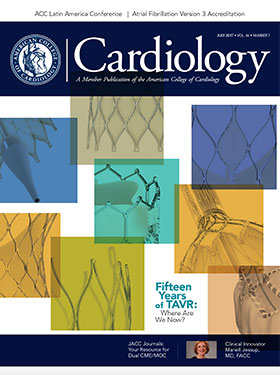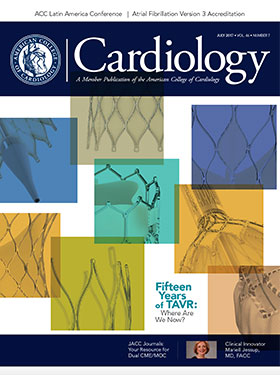NCDR Studies Highlight Room for Growth in Quality Evaluation, Prevention Measures
NCDR, the ACC’s suite of 10 registries, provides researchers, physicians and health systems access to data on a wide range of clinical topics and cardiovascular procedures to answer complex questions on patient risk factors and outcomes, adherence to guidelines and more. A handful of NCDR-based studies were published recently in the Journal of American College of Cardiology and its sister journals, highlighting quality metrics, treatment adoption trends and more. Here we highlight one study that looked at using an assessment of operator variability as a measure of operator PCI performance and another study documenting the underuse of oral anticoagulants (OAC).
In-Hospital Risk-Adjusted Mortality: Not a Sole Measure of PCI Quality
Results from a study led by Jacob A. Doll, MD, et al., found that in-hospital risk-adjusted mortality rates should not be the only metric to evaluate PCI quality. Their study, published in JACC: Cardiovascular Interventions, found significant variability in the risk-standardized mortality rate (RSMR) — a metric suggested to evaluate the performance of PCI operators — amongst U.S. operators who met minimum volume standards.
Using data from ACC’s CathPCI Registry, the investigators calculated the mean RSMR for PCI operators with an average annual volume of ≥50 cases. A total of 2,352,174 PCIs were performed at 1,373 hospitals between Oct. 1, 2009 and Sept. 30, 2014 by 3,760 operators — 6.5 percent were classified as high outliers, while 4.1 percent were classified as low outliers. The non-outlier group included the remaining 3,362 operators.
The median operator annual volume was 103 PCI procedures, with an overall 1.5 percent in-hospital mortality. The investigators also found significant differences in annual operator RSMR — unexplained by case mix or procedure characteristics. Operator classifications also varied throughout the study. For example, the average non-outlier operator had a high RSMR of 0.29 for the five-year study period.
"We need to continue to support research to better understand why OACs are not being prescribed to people who need them, so ultimately we reduce strokes in patients at risk." — Lucas Marzec, MD
PCI mortality rates for individual doctors may be useful for both doctors and hospitals to assess and monitor their care and see where they need improvement, explains Doll. “It could drive hospitals and doctors to further improve the safety of a procedure that’s already low-risk. However, I don’t see this measure as ready for widespread use as a publicly reported measure or to influence payment,” he adds.
Michael McDaniel, MD, FACC, notes that “in-hospital risk-adjusted morality is an imprecise and probably inaccurate reflection of the quality of a PCI procedure. Moreover, reporting mortality after PCI can promote risk averse behaviors.” In an accompanying editorial comment, he suggests quality of care for patients with coronary artery disease would be more informed “if risk-adjusted mortality were measured based on clinical presentation, included all patients regardless of treatment strategy, and evaluated over longer periods of time rather than in-hospital.”
Underuse of OAC For AFib Patients at High Risk For Stroke
The anecdotes of the underuse of OACs in atrial fibrillation (AFib) have been documented: approximately four in 10 patients with AFib may not be prescribed or may not be taking the right dose of an OAC to reduce their risk of stroke. Consequently, hundreds of thousands of AFib patients may have preventable strokes each year.
Lucas Marzec, MD, and colleagues, used the ACC’s PINNACLE Registry and identified 655,000 patients who had nonvalvular AFib and a CHA2DS2-VASc score of >1 between April 1, 2008 and Sept. 30, 2014 to examine the effect of the availability of direct oral anticoagulants (DOACs) on overall OAC rates. The results were published in the Journal of the American College of Cardiology.
Only a slight increase in the overall rates of OAC were found — from 52.4 percent to 60.7 percent — over the seven-year study period. Further, younger, healthier AFib patients were more likely to be prescribed a DOAC.
Significant practice-level variation in the consistent use of any OACs or DOACs also was found. The proportion of practices using OACs ranged from 11 percent to 78.8 percent, while practices using DOACs ranged from zero to 40.4 percent. The findings suggest that DOAC availability alone will not result in optimal OAC use in AFib patients.
While DOACs have been found to be equivalent or more effective than OACs, “there are still wide disparities in how they are prescribed,” says Marzec. “For example, we found that patients at the highest risk of stroke were the least likely to be treated with a DOAC.”
Marzec adds that, “We need to continue to support research to better understand why OACs are not being prescribed to people who need them, so ultimately we reduce strokes in patients at risk.”
“The current analysis provides a sobering message to clinicians” and “should incite an urgent call to action,” note Eric D. Peterson, MD, MPH, FACC, and Sean D. Pokorney, MD, MBA, in a related editorial comment. The strongest predictor of OAC use and adoption of DOACs in this study was providers — thus, they highlight the need for “examination of ‘leading versus lagging’ centers to identify practices and processes that lead to more consistent evidence-based care.”

 |
|
| Click the cover image above to read the latest issue of Cardiology in e-pub format or click here to read it on the web! | |
Keywords: ACC Publications, Cardiology Magazine, Coronary Artery Disease, Risk Factors, Atrial Fibrillation, Hospital Mortality, Registries, Stroke, Anticoagulants, Diagnosis-Related Groups
< Back to Listings

